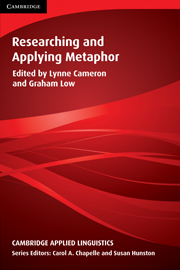Book contents
- Frontmatter
- Contents
- List of contributors
- Acknowledgements
- Conventions
- Series editors' preface
- Preface
- I KEY ISSUES IN METAPHOR RESEARCH
- II FROM THEORY TO DATA
- III ANALYSING METAPHOR IN NATURALLY OCCURRING DATA
- 7 Who framed SLA research? Problem framing and metaphoric accounts of the SLA research process
- 8 Bridges to learning: Metaphors of teaching, learning and language
- 9 Corpus-based research into metaphor
- IV ANALYSING METAPHOR IN ELICITED DATA
- References
- Index
7 - Who framed SLA research? Problem framing and metaphoric accounts of the SLA research process
Published online by Cambridge University Press: 05 October 2012
- Frontmatter
- Contents
- List of contributors
- Acknowledgements
- Conventions
- Series editors' preface
- Preface
- I KEY ISSUES IN METAPHOR RESEARCH
- II FROM THEORY TO DATA
- III ANALYSING METAPHOR IN NATURALLY OCCURRING DATA
- 7 Who framed SLA research? Problem framing and metaphoric accounts of the SLA research process
- 8 Bridges to learning: Metaphors of teaching, learning and language
- 9 Corpus-based research into metaphor
- IV ANALYSING METAPHOR IN ELICITED DATA
- References
- Index
Summary
Introduction
This paper takes its initial inspiration from the work of Schön, who over 15 years ago offered the following explanation of what he calls “problem framing”:
There is a very different tradition associated with the notion of metaphor, however – one which treats metaphor as central to the task of accounting for our perspectives on the world: how we think about things, make sense of reality, and set the problems we later try to solve. In this second sense, ‘metaphor’ refers both to a certain kind of product – a perspective or frame, a way of looking at things – and to a certain kind of process – a process by which new perspectives on the world come into existence.
(Schön, 1979: 254)It is important to examine in detail the two-part function of metaphor in this quote. First of all, there is metaphor as process, that is “metaphors as central to the task of accounting for our perspectives on the world” and “as a process by which new perspectives on the world come into existence”. In this paper I shall adopt the stance that metaphor is an ongoing process by which we constantly assimilate input by comparing and contrasting it with representations of previous experiences which we retain in our memories. It thus constitutes an interplay between top-down and bottom-up processing. The roots of this view of metaphor are to be found in the work of Neisser (1976) who describes what he calls the “perceptual cycle” (pp. 63–70).
- Type
- Chapter
- Information
- Researching and Applying Metaphor , pp. 135 - 148Publisher: Cambridge University PressPrint publication year: 1999
- 7
- Cited by



